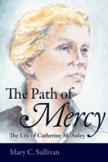A Woman in Full
I came to Mary C. Sullivan’s biography of Catherine McAuley with several entrenched assumptions about the level of interest a 19th-century Irish founder of a women’s religious order could possibly inspire. These assumptions were handily challenged by the narrative sweep that Sullivan maps out for the subject, who founded the Sisters of Mercy in 1831. Sullivan’s highly focused, though somewhat uneven exploration of Catherine’s life and times reveals that Catherine McAuley was socially shrewd yet intensely spiritual, fragile yet capable, forceful yet full of warmth and humor. This book thus invigorates the many dimensions of Catherine’s character, spirituality and work of serving the poor and outcast.
Sullivan conveys these ideas with a richly detailed prose record of Catherine’s activities, made possible by a wide variety of primary sources and written reflections by those who knew her. And those who knew her were many. From the moment the mature, unmarried Catherine came forward with her plans to turn a building she was constructing on Dublin’s Baggot Street into a sanctuary for the poor, the idea attracted other laywomen who wanted to help implement the plan. How she attained the means to make this happen is one of the most intriguing, and perhaps elusive, passages in the book. Orphaned by age 18, Catherine spent much of her adult life as a dependent in the homes of others. At first her hosts were relatives, but when they found themselves in strained circumstances, Catherine went to live with family friends, Catherine and William Callaghan, who were wealthy, loving, indulgent, supportive—and not Catholic. In their household, Catherine kept her growing commitment to Catholicism quiet out of respect for her hosts, a Quaker and an Anglican.
It was an inheritance from William Callaghan that underwrote her activities as a social activist in the name of God. In her 40s at the time of William’s death, Catherine was for the first time mistress of her own life and the possessor of a handsome fortune in cash and property—a situation that raised some eyebrows, especially in light of the fact that Catherine had continued to live with William Callaghan after his wife died. It would not be the last time that the propriety of Catherine’s activities was called into question. Another, far more notable occurrence was the actual founding of the Sisters of Mercy as a religious order, a pragmatic response to the gender-based realities of laywomen publicly ministering to Ireland’s needy.
As a social historian of religion, I read this book in the constant hope that the author would fully contextualize her subject’s remarkably eventful life. After all, Catherine was not only an important figure in her own right, but crossed paths with other 19th-century notables, including the Irish political activist Daniel O’Connell, the eminent architect and Catholic convert Augustus Pugin, the celebrated Temperance Priest, Theobald Mathew, and Princess (later Queen) Victoria.
She was also a woman who built—literally—large, task-specific buildings, interacted regularly with and at times vocally disagreed with men who answered to the Roman hierarchy, established her order in overwhelmingly Protestant England as well as Catholic Ireland and saw adored associates, friends and family members die in droves from terrible diseases and starvation.
What was it like to be a 19th-century woman in these circumstances? Unfortunately, this book does not tell the reader, at least not consistently. Similarly, the level of detail focused on Catherine’s immediate activities often obscures this larger story. I finished this book knowing many specifics about Catherine McAuley, but not very much about the Ireland in which she lived and worked.
Yet this book succeeds in other ways, chiefly in its ability to inspire a personal connection with Catherine and a sense of awe at what she was able to achieve in her lifetime. Sullivan’s skills in reconstructing a life shine when she assesses the forces, inspirations and challenges that shaped Catherine’s spiritual life. Described in particularly beautiful prose is one of the animating influences of Catherine’s spirituality: her belief in “human acceptance of one’s ‘portion of the Holy Cross.’” Sullivan demonstrates that Catherine lived this belief almost daily and bore it with unflagging conviction and grace.
Mary C. Sullivan does not state explicitly that Catherine’s story holds lessons for our times. But reading this book against the backdrop of recent pronouncements from the Vatican about the work and priorities of some American nuns cannot help but inspire parallels. Despite the support and friendship of numerous clerics, Catherine too had her frustrations and dissonances with the church hierarchy. Even in the months before her own lingering death, she strenuously objected to changes made to the Sisters of Mercy’s official, approved rule—and the fact that the final document had been prepared and presented to the Sisters in Italian, not English. As presented in this book, Catherine McAuley’s conviction that she knew best for the people she organized and those she served was worthy of patient, good-humored defense.
This article also appeared in print, under the headline “A Woman in Full,” in the November 19, 2012, issue.








